EDIT (10/2/2021): Please note that this article contains many statements which, through subsequent research, I discovered are factually incorrect, especially the alleged connection to Confederate General James Longstreet. Click on the "longstreet palms" tag here or at the bottom of the page to read the most recent and accurate findings on this very interesting subject!
It's funny how things that we don't pay any attention to at first can gradually worm their way into our consciousness and eventually become an obsession.Here's how one such obsession of mine began. As you can tell from my blog, one of my hobbies is collecting postcards of old Los Angeles; a common subject of which is a "palm drive" or "palm avenue," depicting a street lined usually on both sides with either native or exotic palm trees. Stereotypical California scenes, I thought, of no real noteworthiness. So, I generally ignored these palm-themed postcards – my specialty is downtown street scenes and buildings – but after a while, I started to notice that a lot of the really old palm postcards appeared to depict one specific location: one on or near West Adams Street.
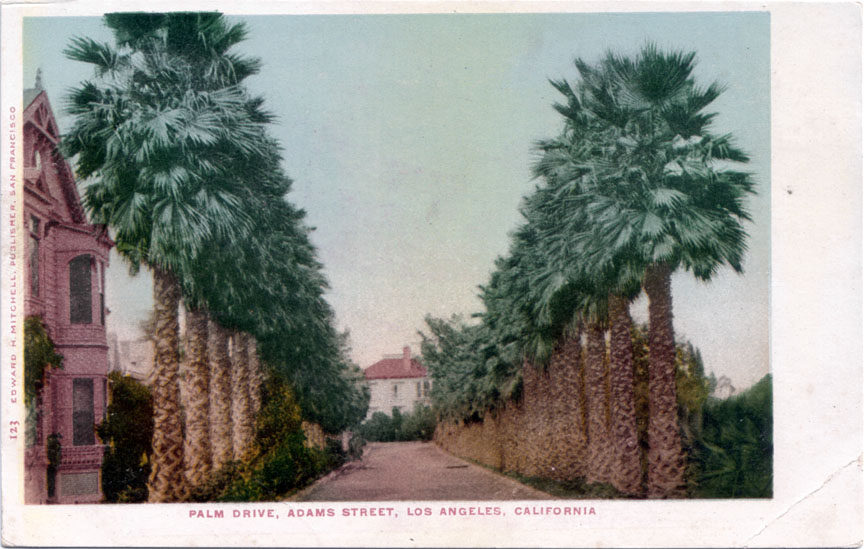
Curious, I looked it up in my 1941 "Hill's Guide" of Los Angeles, and was somewhat surprised to learn that Palm Drive was an actual place.

Then, I went to Google Maps to check the location today. I recognized the area immediately. It's an old memory from my childhood, actually. Palm Drive is located on what is now (or was) the campus of the world-renowned Orthopaedic Hospital. I almost stopped my search for the palms at that point, thinking it unlikely they'd still be there. But just on a whim, I decided to have a look at the location with Street View. What I found simply blew me away. Amazingly, the palms still lived!
View Larger Map
Look how tall they are! Given that the early postcards of these palms were from the first decade of the 20th century, this meant they were at least a full century old. Truly remarkable! What I was about to find out, though, is that these palms were, in fact, much older, and even more remarkably, they had an improbable connection to a well-known figure in American history...

Cutting to the chase: in the course of my research, I uncovered convincing evidence that these two rows of Washingtonia fan palms could very well be the oldest living things in Los Angeles. They were planted by none other than Confederate General James Longstreet, about 135 years ago. That may not sound terribly ancient, but to better frame the time perspective, there are only 4 man-made structures still standing in all of Los Angeles that are older than these palm trees.
I compiled the following pictoral history principally by piecing together photos and bits of information I gleaned from two online archives: the USC Libraries Digital Archive, and the photographic collection of the Los Angeles Public Library. Now, watch the palms grow through the years!
c.1875: This is the earliest photo of Palm Drive that I've been able to find. ("Early" defined in terms of the height of the trees themselves.) How old are they here, really? There's a house near mine that was built around 1992 that has a Washingtonia in its front yard that is about as tall as these are below. From that, I infer that these historic palms probably began life around 1860. That would make them almost 150 years old today. It was from the text accompanying this photo that I learned about the connection to Gen. Longstreet (that's his home at the end of Palm Drive).
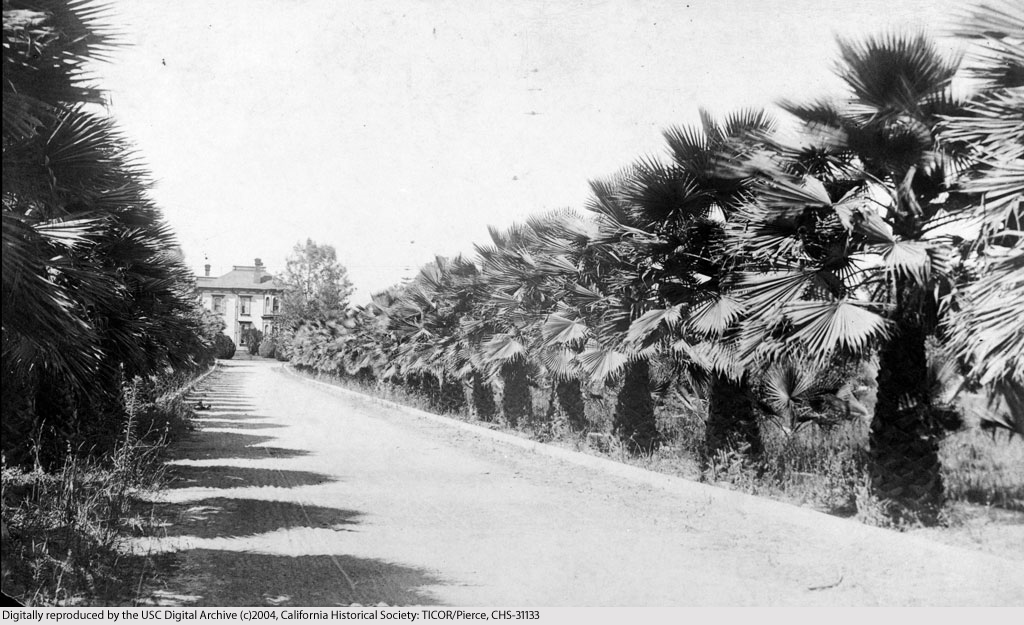
Courtesy U.S.C. Digital Library.
1886: More information about Longstreet and his estate: "From a letter to the Herald Express (1940 February 5): 'About 1875, Confederate General Longstreet acquired the 40 acres on the northeast corner of Figueroa and West Adams streets. He did what was possibly up to that time the most extensive grading job done in Los Angeles. He made a pleasing slope up to where the house was to be built, a slope such as we used to read about in southern love stories. He built a mansion of Southern grandeaur [sic] and elegance and made the entrance from West Adams, between the palms which he planted, a southern romance. He planted the whole place with orange trees and it became the showplace of Southern California...'."
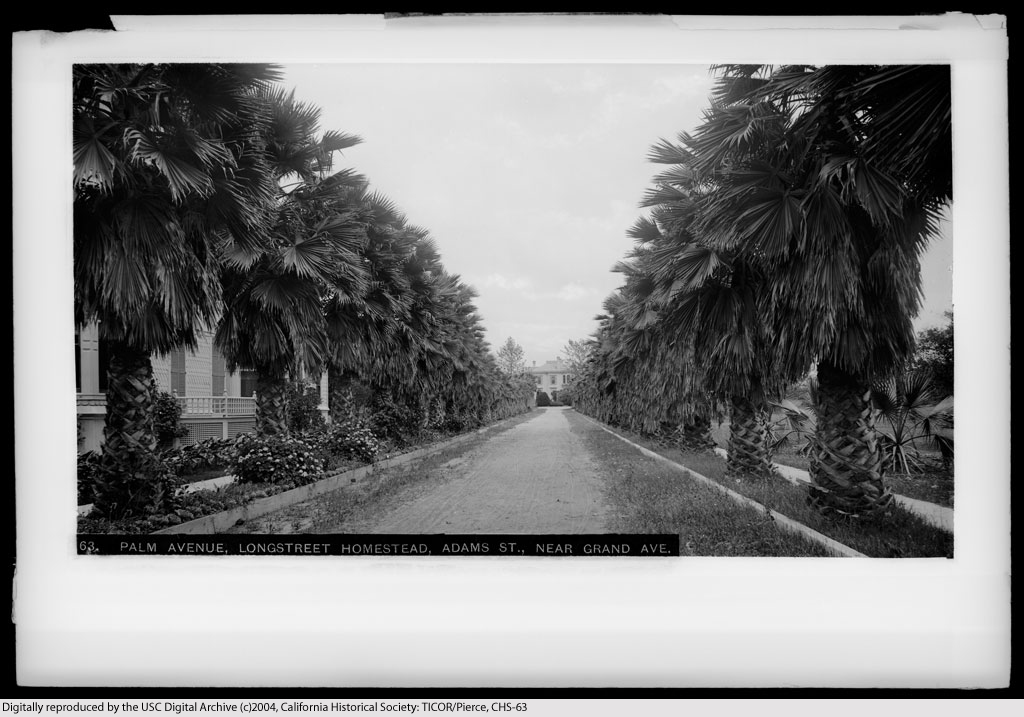
Courtesy U.S.C. Digital Library.
c.1900: This scene looks very similar to the photos of Palm Drive in the earliest 20th century postcards (e.g., as above), so even though this photo is undated, around 1900 seems about right. Here is a photo of General Longstreet's estate's grounds taken around 1890-1900. The caption mentions that the house at this time "was in use as an osteopathic hospital." The website for Orthopaedic Hospital says the clinic was founded in 1911, but evidently the property's history as a place for treating bone disorders extends back in time to the late 19th century when the property was still owned by Gen. Longstreet himself.
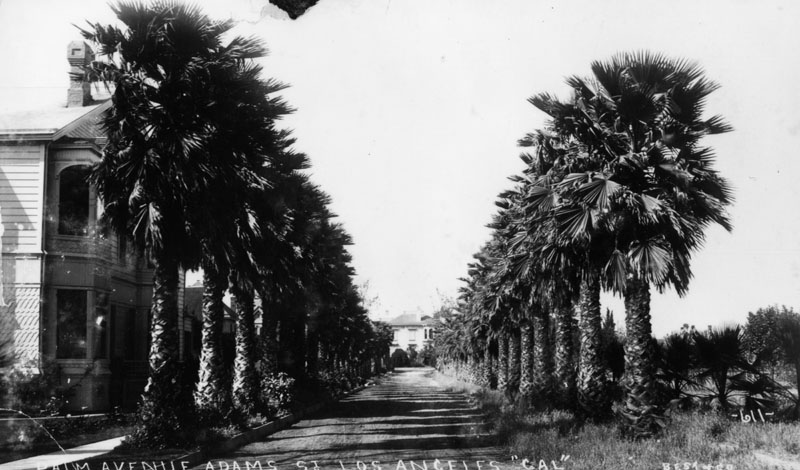
Courtesy Los Angeles Public Library.
c.1910: The referenced page says this photo was taken around 1920, but I guesstimate it was more likely taken closer to 1910.
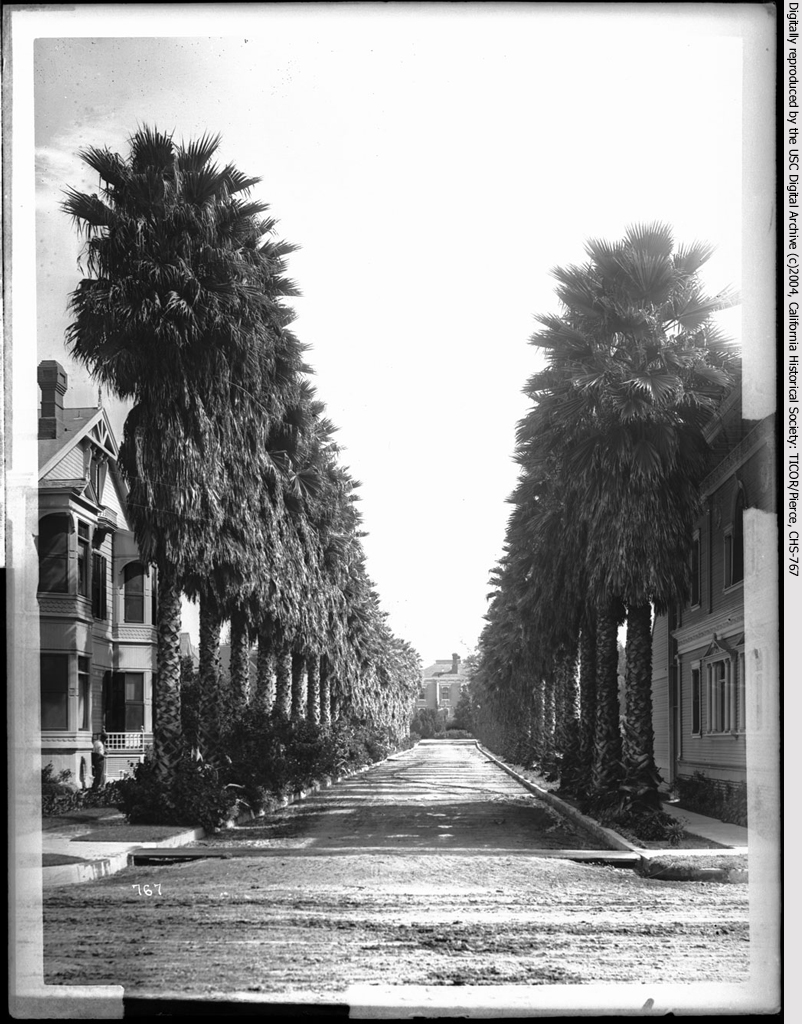
Courtesy U.S.C. Digital Library.
c.1920: The text accompanying this photo gives the account that, at the time, these were the "tallest palm[s] in the city." Aha! Logically, if these were the tallest, then they were also likely the oldest. The more famous palm-lined avenues of Beverly Hills were just being planted in the late 'teens/early '20s. The trees of Palm Drive were already about 60 years old by then.
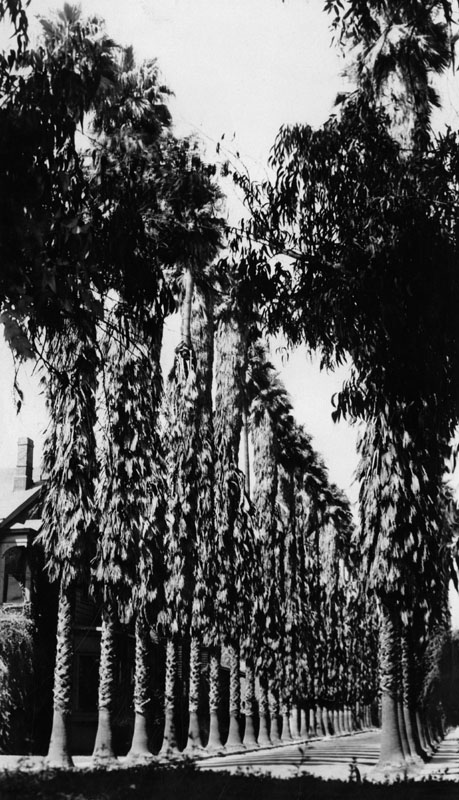
Courtesy Los Angeles Public Library.
c.1928: From the back cover of "La Reina - Los Angeles in Three Centuries," published by Security Trust & Savings Bank, 1929. The palms are truly in their prime! General Longstreet's house is gone now, and at right is the Holton Arms, an upscale West Adams "apartment hotel."
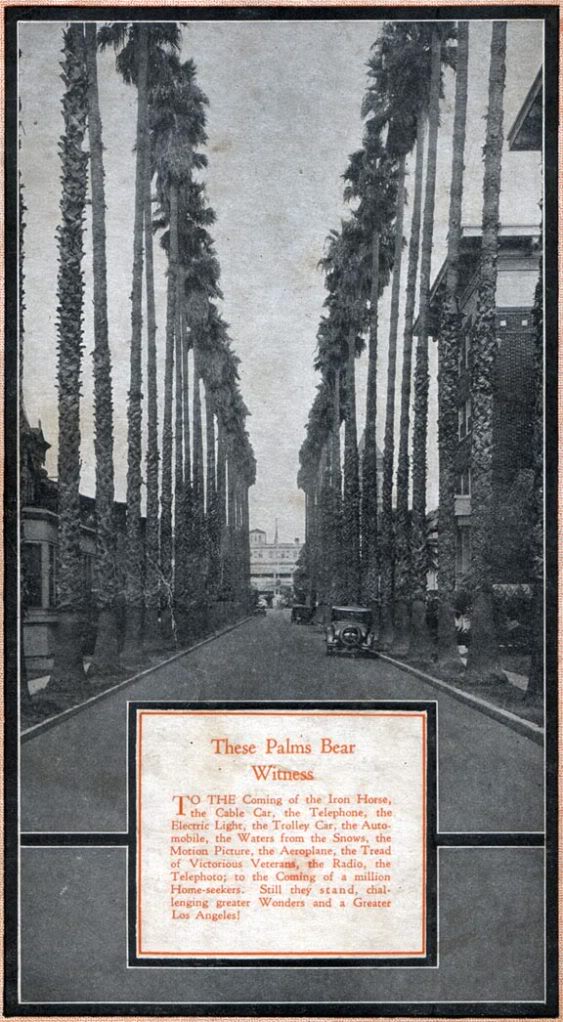
c.1940: This is the latest photo I was able find of the historical palms in the online archives. By this time, even before WWII, they had been here for 65 years, and were approximately 80 years old...
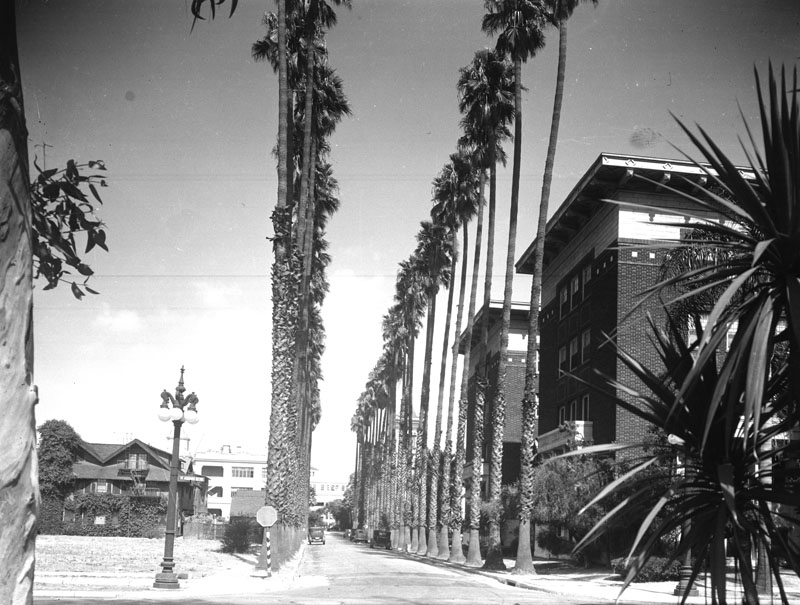
Courtesy Los Angeles Public Library.
And it just so happened that while I was beginning to put the finishing touches on my information search, one of my favorite L.A. blogs (Larry Harnisch's The Daily Mirror) reprinted a column about General Longstreet's palm trees that had appeared in the Los Angeles Times 70 years ago, on July 8, 1938:

Click image for source.
Reading this old "Nuestro Pueblo" article was a big thrill, as it provided independent confirmation of many of the factoids I'd found in the USC and LAPL archives, with the happy inclusion of Mrs. Lucy Longstreet's role in the story.

On to the present day... via the web, I've learned that the site of Orthopaedic Hospital was sold in 2006, and that its redevelopment for luxury apartments commenced in 2007. According to this page, it appears at least some of the ancient palms have already been removed; perhaps all of them are gone now, I don't know. I don't live in the L.A. area, or I would definitely look into this myself.
It would truly be a shame to lose these venerable survivors. I wonder if anyone else but me has any idea just how old or significant these palms really are – that they were planted by a famous Confederate General and his wife, that they were once a celebrated showpiece of Los Angeles, and that today, they might just be the oldest living things in the entire city. Are Gen. Longstreet's palms really gone? I sincerely hope not...
Read the next installment in the saga of the Longstreet Palms: 'Whose palms are these, anyway?'
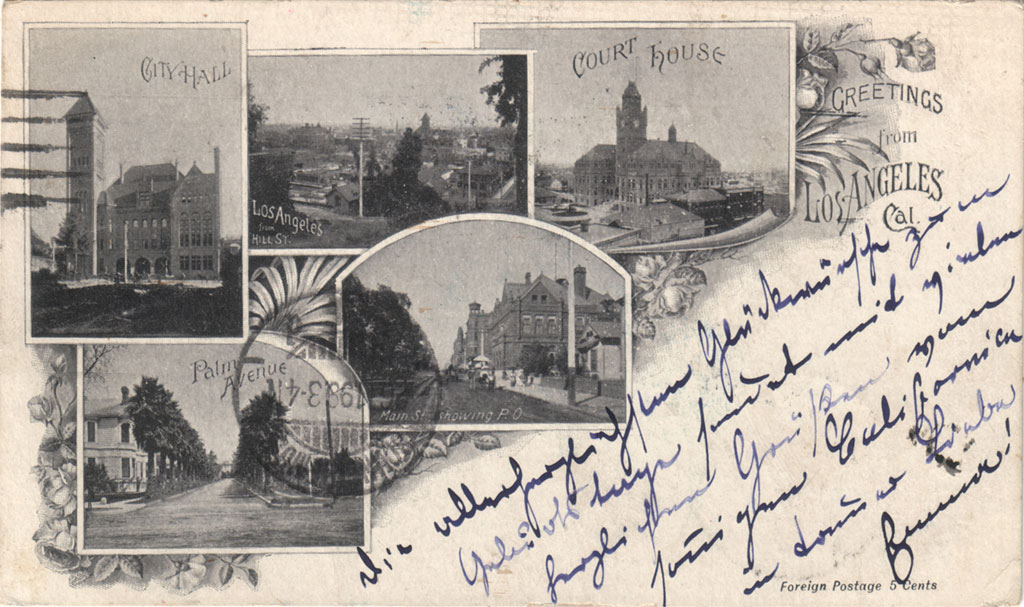
An 1899 postcard featuring "Palm Avenue."
13 comments:
This is an amazing history. So much so, that the day I read it, I hopped on the 81 bus that goes from my home in Highland Park to the location of Palm Drive and took these photos myself:
http://www.flickr.com/photos/waltarrrrr/sets/72157622173641598/
Thank you, and I hope the rest of 23 get historic monument status.
Walt, that's wonderful! I'm gratified that my post inspired you to go visit the palms. Believe me, when I was researching the subject last year, it drove me crazy that I couldn't visit and confirm that the palms were still there. So when I came to Los Angeles last month, that was #1 on my list of things to do. I was overjoyed to see that at least some of the palms remained.
It's funny - I grew up in the L.A. area, so I always took palm trees totally for granted. I paid no attention to them at all. But, after finding out how truly ancient the palms of Palm Drive are, suddenly I found myself fascinated by them. It was almost a mystical experience being in their presence. Knowing they started life even before the Civil War - that's something awesome to contemplate. I really wished those trees could talk!
I liked your Flickr set, too. My favorite is the one with St. John's Cathedral in the background. The church and the palms have been neighbors for 80 years, so it's nice to see them pictured together like that. :)
I read once that these were dragged by donkeys all the way from Palm Springs...
Very interesting! I'd never heard about where the palms came from originally. Do you maybe recall where you read that?
A current googlemaps search shows that the palms are still there. Have you ever contacted the L.A. Conservatory or a newspaper writer with your fascinating story of these palms? I congratulate you for "discovering" this.
Rich
rwojcik@socal.rr.com
I got interested in this location as a follow-up to my search about Rose La Monte Burcham, who was a principal in the Yellow Aster Mine, along with John Singleton, who was the owner of the Longstreet mansion in 1900.
It appears that the Longstreet here was Charles A. Longstreet, married to Lucy Longstreet. There were at least three sons-- Cornelius Tyler (named after his grandfather), Guy, and Dennis. Charles was a wealthy clothing wholesaler out of Syracuse, New York, and died in 1877 in Los Angeles. The house ended up being sold around 1884, along with the surrounding land.
Why or when the "General" part came into legend, I haven't come across it yet.
I find this to be amazing! For years as a student at, then employee of, USC, I'd often exit the 110 N at Adams. At the top off the off-ramp, and directly ahead, stands these 2 rows of very tall palms. I had no idea they were so old! And looking at Google Maps this morning, they still stand - the new Metro Expo line goes right past them as it crosses Adams. Thanks for the info! :)
I also grew up in Los Angeles, not too far from this location, and I recall seeing those rows of palms as a child as we drove on the 110 freeway. I just took a look at them on google maps, and although many are still there, they sure do look lonely. They now live in a sea of pavement!
To add to Bradford's comments (and I left this on the other post on this subject on this blog): Charles A. Longstreet was set up in the wholesale clothing business in New York City in 1855 by his highly-successful clothier father, Cornelius (who is credited with sending the first ready-made clothes to Gold Rush Califoprnia in 1849.) With respect to the Homestead, the property was subdivided into 34 lots and put up for sale in 1887, when a massive land boom was underway in Los Angeles. It is interesting that an ad for the subdivision claimed that Charles spent $100K on the landscaping and grounds alone and quoted a Harvard botany professor as stating that the grounds had "the finest and rarest collection of plants and trees ever seen" in the U.S. On the misidentification of Gen. Longstreet of Civil War notoriety, an 1896 biography of Cornelius Longstreet stated that there were three brothers who migrated to colonial America from Holland. One, the ancestor of Cornelius and Charles, went to New Jersey. Another settled in Pennsylvania. The third migrated to Georgia and that is supposed to be the line that produced the general. Paul R. Spitzzeri, Assistant Director, Workman and Temple Family Homestead Museum (which has several photos of the Longstreet house and grounds in its collection.)
Thank you, Mr. Spitzzeri, for your very informative addenda. Thank you very much, indeed.
Indeed. Very interesting. This history of Palm Avenue is fascinating. But General Longstreet did NOT own any property there or anywhere else in California. The property on Palm Ave. was owned by Charles A. Longstreet, a distant cousin of General James Longstreet, who descended from a branch of the family that moved to New York and then to California. The misinformation that General Longstreet owned the property on Palm Ave. in Los Angeles has spread around the internet. Please help correct this.
Clark Thornton
g-ggrandson Gen. Longstreet
Hello,
> Great research on the Longstreet Homestead on Palm Ave. in Los Angeles. Very well done and thorough.
> Just wanted to make an observation based on my research. The Charles A. Longstreet (Charles Augustus Longstreet who married Lucy Eddy on 30 Oct 1861) referred to in your blog was a wholesale clothing merchant who moved to Los Angeles from New York and became very wealthy with the help of his father, Cornelius Tyler Longstreet. He and General James Longstreet were 3rd cousins once removed.
> General Longstreet did visit California once as part of his duties as U.S. Railroad Commissioner and briefly stayed at the house of Frederick Dent, a son of President U.S. Grant. Gen. Longstreet and U.S. grant were very good close friends before and after the Civil War. General Longstreet travelled frequently by rail inspecting the conditions, progress of, etc. of the U.S. railroad system in the late 1800s and early 1900s.
> I can find no instance, except in commentary, of Charles A. Longstreet ever being called General Charles Longstreet. As a mater of fact, there has never been a General Charles Longstreet that I have been able to discern in my research on this Longstreet family over the last thirty years. It may have been a courtesy military title (but these are usually Col., Maj. or Capt., etc), however, I cannot find a courtesy military title used at all for Charles A. Longstreet, before or while this Longstreet family owned the property in Los Angeles. It can only be found in commentary about the property.
> Just thought I would add my two cents worth.
>
> Regards,
>
> Clark T. Thornton
Thank you to Clark T. Thornton, Paul R. Spitzzeri and others for their important corrections and clarifications. I've since confirmed that almost all of the information in their comments is factual. I'll be following up soon with a final article summarizing what we now know for certain about the Longstreet Palms.
Post a Comment
Note: Only a member of this blog may post a comment.